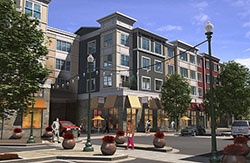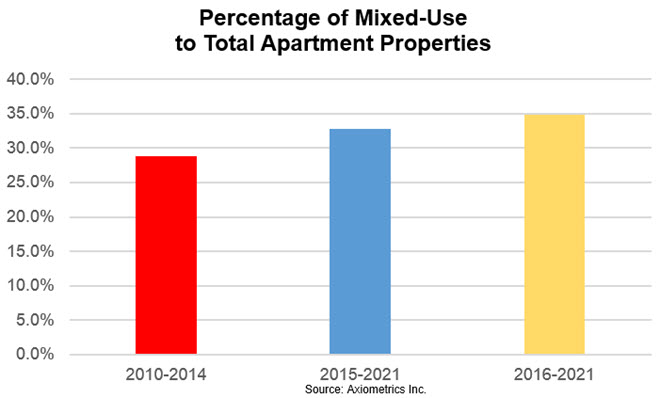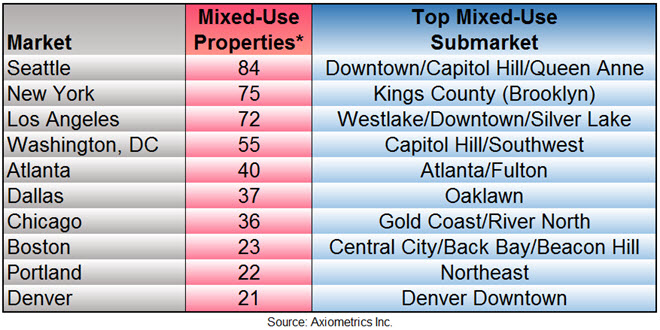Mixed use Combo Developments One-Third of all Projects
Dave Sorter, February 22, 2016
One reason renting by choice has become popular in the apartment market is that millennials and empty-nest baby-boomers are gravitating toward neighborhoods that offer a “live-work-play” environment. Many of today’s renters seek the ability to walk from their residence to retail, restaurants, entertainment and the workplace.
Developers have been answering this trend by putting many of these functions inside of one property – in other words, mixed-use development, combining residential, retail, dining and other real-estate types. The typical project features ground-floor shopping and dining; parking on the next few levels and apartments on floors 4 or 5 and up. The first-floor storefront is important for merchants to attract walk-in traffic from the busy sidewalk.
“Millennials and empty-nesters want community, connection and an urbane village feel,” Paula Reese, principal at Seattle-based design firm Foreseer, told “Development Magazine.”
Though mixed-use is nothing new, more and more of these types of developments have sprouted up the past few years. For example, 28.8% of apartment properties in the pipeline from 2010-2014 were of the mixed-use variety, while 32.8% of those delivered or planned for delivery in 2015-2021 include a variety of uses. The percentage rises to 34.9% for properties identified for delivery from 2016-2021.
“The walk-up two- and three-story garden-style apartment development, with adjacent retail and restaurants, are less often constructed,” said Andrew H. Smith, principal at Dallas-based Jordan & Skala Engineers, during a panel discussion published in “Consulting-Specifying Engineer.” “Building high-density and mixing ‘live-work-play’ on one site is desired by the millennial generation and is also green/sustainable.”
The 1,023 mixed-use properties delivered or in the pipeline from 2013-2021, as of Feb. 14, 2016, are spread throughout the country, with large concentrations in the Northeast and West Coast. The South, except for Atlanta, is not following the trend. The table below lists the top 10 markets for mixed-use development that includes apartments:
Several metros with the strongest annual effective rent growth in January, such as Portland, Seattle and Los Angeles, have a large amount of mixed-use development, though the San Francisco Bay Area and Florida have a smaller amount.
Seattle is the king of mixed-use development, with 90% of housing construction consisting of either mixed-use or multifamily, “The Urbanist” reported in February 2015. The Washington Partners corporate real estate firm’s blog said “The 18-Hour City” will be among the hot trends of 2016.
It’s no surprise that a large portion of the mixed-use projects are being built in urban-core/center-city areas. Seattle’s Downtown/Capitol Hill/Queen Anne submarket counts 36 mixed-use properties in the 2013-2021 pipeline – which, if it were its own city, would tie Chicago for No. 7 on the above table.
Elsewhere, the Atlanta/Fulton submarket has 24 of Atlanta’s 40 mixed-use developments, Denver Downtown sports 14 of the metro’s 21 such projects, Montrose/River Oaks contains 11 of Houston’s 18 mixed-use properties, and the Oaklawn submarket has 15 of Dallas’ 37 projects.
Though Brooklyn isn’t considered the urban core, it does have the highest concentration of apartment construction in New York, and it shows in the mixed-use proportion. The Kings County submarket has 23 mixed-use developments in the 2013-2021 pipeline, while Manhattan submarkets have only 16.
Mixed-use developments in other metros are more spread out. Some 27 of Los Angeles’ 72 mixed-use projects are in the urban core, while none of Washington, DC’s submarkets has more than nine of the metro’s 55 properties. The two Fairfax County submarkets total 11 mixed-use projects.
In general, mixed-use developments tend to be located in the center city – with some suburban projects in higher-density areas, such as Legacy Park in the Dallas suburb of Plano, which will soon be home to new Toyota and FedEx headquarters. The center-city areas are usually more walkable than suburban areas, therefore more conducive to mixed-use projects.
And attractive to all those renters-by-choice.
Axiometrics Pipeline Development Specialist Lauren Beasley contributed to this report.
The report was posted on AXIO Metrics Inc. and can be found HERE.





